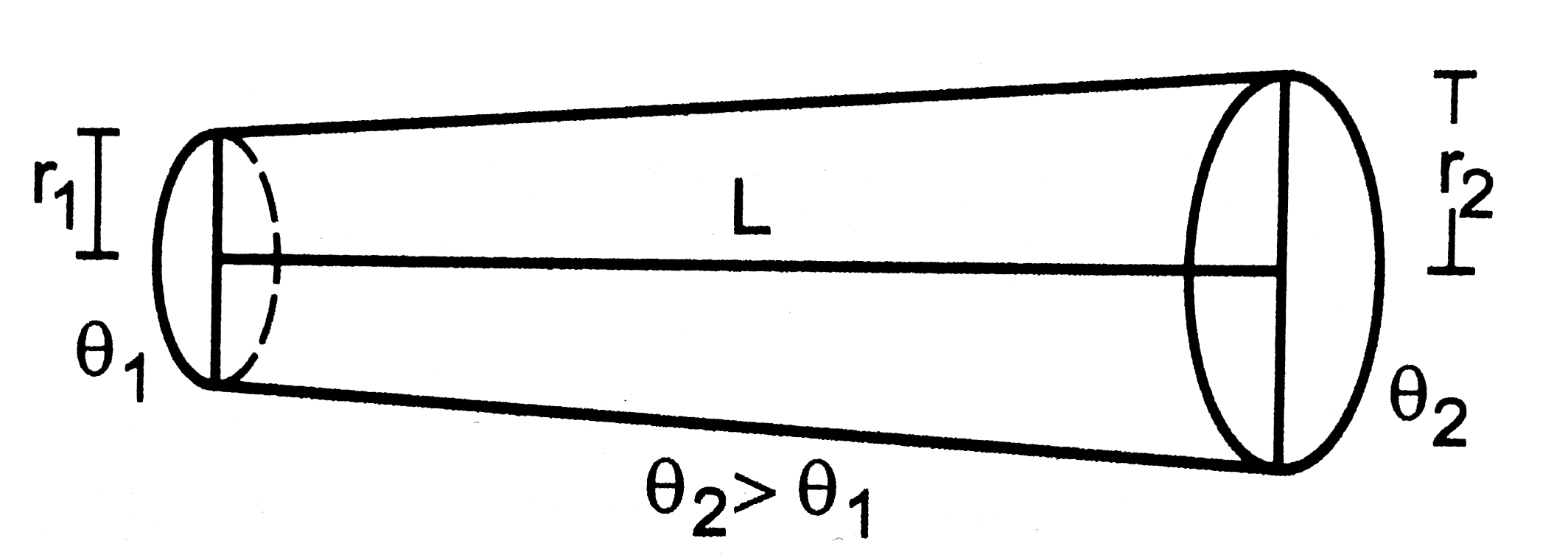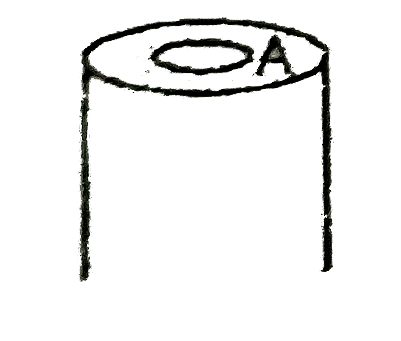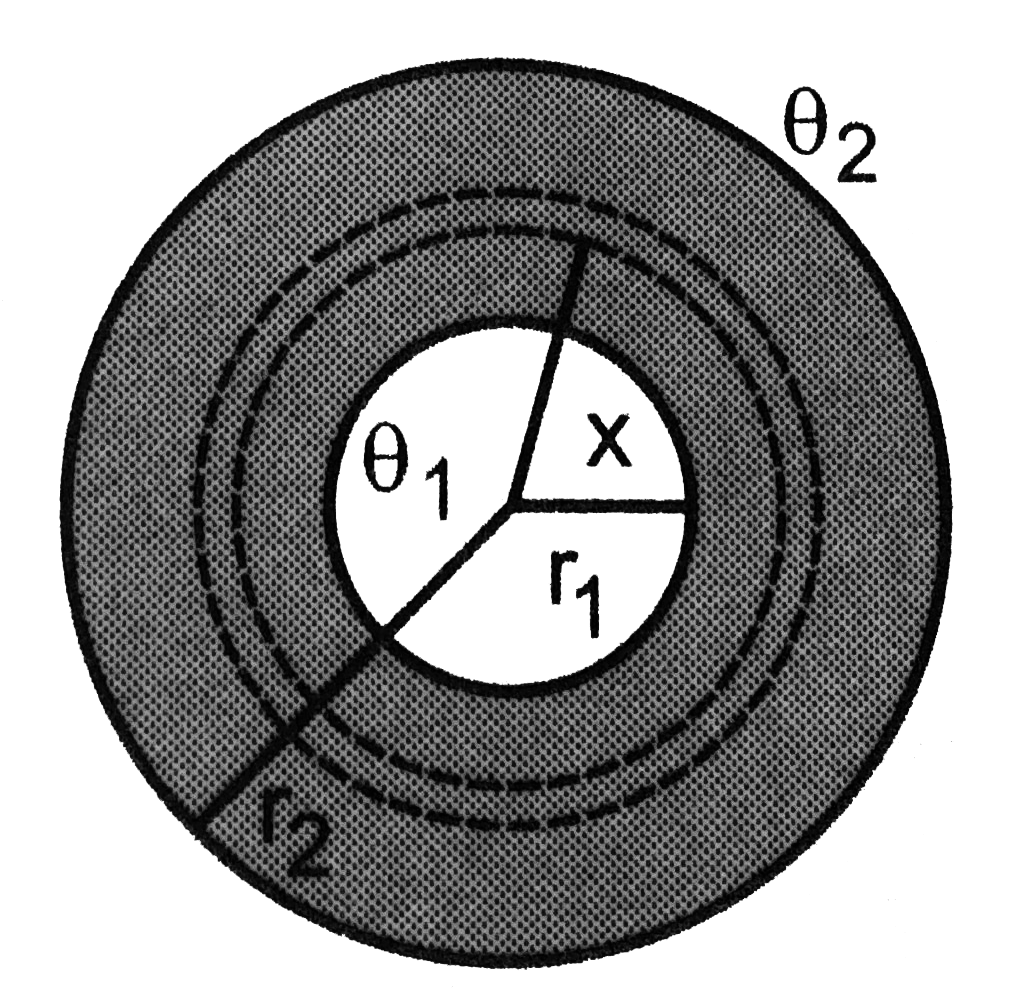A hole of radius r1 is made centrally in a uniform circular disc of thickness d and radius r2 . The inner surface (a cylinder of length d and radius r1) is maintained at a temperature θ1 and the outer surface (a cylinder of length d and radius r2) is maintained at a temperature θ2(θ1>θ2) .The thermal conductivity of the material of the disc is K. Calculate the heat flowing per unit time through the disc.
The correct Answer is:A, B, D
To solve the problem of calculating the heat flowing per unit time through a circular disc with a hole, we can follow these steps:
Step 1: Understand the Setup
We have a circular disc with:
- Inner radius r1
- Outer radius r2
- Thickness d
- Inner surface temperature θ1
- Outer surface temperature θ2 (where θ1>θ2)
- Thermal conductivity K
Step 2: Apply Fourier's Law of Heat Conduction
According to Fourier's law, the heat transfer Q through a material is given by:
Q=−KAdTdx
For a cylindrical shell at radius r with thickness dr, the area A is given by the lateral surface area of the cylinder:
A=2πr⋅d
Thus, we can express the heat transfer through the ring as:
dQ=−K(2πrd)dTdr
Step 3: Rearranging the Equation
Rearranging gives us:
dQ=−2πKd⋅rdTdr
Step 4: Integrate to Find Total Heat Transfer
To find the total heat transfer Q from the inner radius r1 to the outer radius r2, we integrate:
Q=∫T2T1dQ=−2πKd∫r2r1rdTdrdr
Step 5: Change of Variables
We can express dT in terms of dr:
dTdr=θ2−θ1r2−r1
Substituting this into the integral gives:
Q=−2πKd(θ2−θ1r2−r1)∫r2r1rdr
Step 6: Evaluate the Integral
The integral ∫rdr evaluates to:
∫r2r1rdr=(r22)r2r1=r222−r212=12(r22−r21)
Step 7: Substitute Back into the Equation
Substituting the evaluated integral back into the equation for Q:
Q=−2πKd⋅(θ2−θ1)(r2−r1)⋅12(r22−r21)
Step 8: Final Expression for Heat Transfer
The negative sign indicates the direction of heat flow (from higher to lower temperature). Thus, the total heat transfer per unit time through the disc is:
Q=2πKd(θ1−θ2)ln(r2r1)
We have a circular disc with:
- Inner radius r1
- Outer radius r2
- Thickness d
- Inner surface temperature θ1
- Outer surface temperature θ2 (where θ1>θ2)
- Thermal conductivity K
According to Fourier's law, the heat transfer Q through a material is given by:
Q=−KAdTdx
For a cylindrical shell at radius r with thickness dr, the area A is given by the lateral surface area of the cylinder:
A=2πr⋅d
Thus, we can express the heat transfer through the ring as:
dQ=−K(2πrd)dTdr
Rearranging gives us:
dQ=−2πKd⋅rdTdr
To find the total heat transfer Q from the inner radius r1 to the outer radius r2, we integrate:
Q=∫T2T1dQ=−2πKd∫r2r1rdTdrdr
We can express dT in terms of dr:
dTdr=θ2−θ1r2−r1
Substituting this into the integral gives:
Q=−2πKd(θ2−θ1r2−r1)∫r2r1rdr
The integral ∫rdr evaluates to:
∫r2r1rdr=(r22)r2r1=r222−r212=12(r22−r21)
Substituting the evaluated integral back into the equation for Q:
Q=−2πKd⋅(θ2−θ1)(r2−r1)⋅12(r22−r21)
The negative sign indicates the direction of heat flow (from higher to lower temperature). Thus, the total heat transfer per unit time through the disc is:
Q=2πKd(θ1−θ2)ln(r2r1)
Topper's Solved these Questions
- BOOK - HC VERMA ENGLISHCHAPTER - HEAT TRANSFEREXERCISE - QUESTIONS FOR SHORT ANSWER11videos
HEAT TRANSFER
- BOOK - HC VERMA ENGLISHCHAPTER - HEAT TRANSFEREXERCISE - OBJECTIVE II6videos
HEAT TRANSFER
- BOOK - HC VERMA ENGLISHCHAPTER - HEAT AND TEMPERATUREEXERCISE - Objective 26videos
HEAT AND TEMPERATURE
- BOOK - HC VERMA ENGLISHCHAPTER - INTRODUCTION TO PHYSICSEXERCISE - Question for short Answer4videos
INTRODUCTION TO PHYSICS
Similar Questions
Find the rate of heat flow through a cross section of the rod shown in figure (θ2>θ1) . Thermal conductivity of the material of the rod is K.
 View Solution
View SolutionCalculate thermal conductance for radial flow of an annular cylinder of length l and inner and outer radius r1 and r2. Assume that thermal conductivity of the material is K
 View Solution
View Solution
Knowledge Check
- Question 1 - Select One
An infinite cylinder of radius ro, carrying linear charge density λ. The equation of the equipotential surface for the cylinder is
Ar=r0eπε0[V(r)+V(r0)]λBr=r0e2πε0[V(r)−V(r0)]λ2Cr=r0e−2πε0[V(r)=V(r0)]λDr=r0e−2πε0[V(r)−V(r0)]λ
Two thin metallic spherical shells of radii r1 and r2 (r1<r2) are placed with their centres coinciding. A material of thermal conductivity K is filled in the space between the shells. The inner shells is maintained at temperature θ1 .and the outer shell at temperature θ2 (θ1<θ2). Calculate the rate at which heat flows radially through the material.
 View Solution
View SolutionTwo thin metallic spherical shells of radii r1 and r2 (r1<r2) are placed with their centres coinciding. A material of thermal conductivity K is filled in the space between the shells. The inner shells is maintained at temperature θ1 and the outer shell at temperature θ2 (θ1<θ2). Calculate the rate at which heat flows radially through the material.
 View Solution
View SolutionThe ends of a metal rod are kept at temperatures θ1 and θ2 with θ2>θ1. The rate of flow of heat along the rod is directly proportional to
View SolutionCalculated thermal conductance for radial flow of a spherical sheel of inner and outer radius r1and r2. Assume that thermal conductivity of the material is K
View SolutionA cylinder of radius R and length L is placed in a uniform electric field E parallel to the axis. The total flux for the surface of the cylinder is given by
View SolutionA cylinder of radius R and length L is placed in a uniform electric field E parallel to the axis. The total flux for the surface of the cylinder is given by
View SolutionA hollow tube has a length l, inner radius R1 and outer radius R2 . The material has a thermal conductivity K. Find the heat flowing through the walls of the tube if (a) the flat ends are maintained at temperature T1 and T2(T2>T1) (b) the inside of the tube is maintained at temperature T1 and the outside is maintained at T2 .
View Solution

